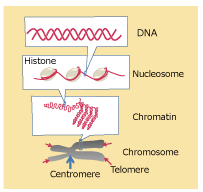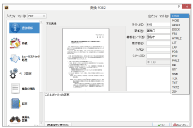|
■ Bioresources information is available at the following URLs
|
 |
|
Research and Bioresources <No. 27> Subtelomere is not a substitute for telomere
Junko Kanoh, Independent Associate Professor
(Institute for Protein Research, Osaka University)
Telomere, a structure at each end of a chromosome |
DNA, which stores genetic information, forms a structure called chromosome by being bound by various substances such as histones. In general, eukaryotes possess linear chromosomes. A chromosome has a “telomere” with an extremely sophisticated mechanism at its each end.
A telomere is composed of telomeric DNA consisting of specific repetitive sequences and numerous proteins that are bound to the telomeric DNA. Recently, research on telomeres has rapidly advanced and numerous findings have accumulated. In particular, the relationship between telomeres and cellular life span has attracted public attention. In germ cells, the activity of telomerase, an enzyme that extends telomeric DNA, is maintained at a high level, and the length of the telomeric DNA is kept almost constant (different species have different lengths). In other words, humans have inherited almost the same length of telomeric DNA as that of extremely remote ancestors. Species can be preserved by passing on telomeric DNA of the right length to successive generations. After an egg is fertilized, telomerase activity is restrained. Owing to this, in somatic cells, the length of telomeric DNA becomes shorter little by little every time the cell divides (properly speaking, every time DNA is replicated). This mechanism has evolved only because DNA synthetic enzymes (other than telomerase) cannot perfectly replicate a chromosome, including its very end part. When telomeric DNA is shortened to a certain length, a cell irreversibly stops dividing and becomes a senescent cell. Therefore, telomeric DNA is akin to a clock that counts cellular life span. |
Subtelomere, a telomere-adjacent region |
At each end of a chromosome, there is a domain called "subtelomere" adjacent to the telomere. The DNA sequence of a subtelomere differs from the repetitive sequences of a telomere, and contains a consensus DNA sequence that is highly conserved amongst subtelomeres.
In the case of fission yeast, which has three chromosomes, the subtelomere exists in chromosomes 1 and 2, but sometimes does not exist in chromosome 3 depending on the line. Chromosomes 1 and 2 contain a 50-kb subtelomeric homologous sequence adjacent to the telomere. Adjacent to this sequence, there is a 50-kb region that is characterized by an extremely low level of histone post-translational modification. In general, the entire 100-kb region (the sequence with 50 kb + the region with 50 kb) is often referred to as the subtelomere. When the subtelomere does exist in chromosome 3, a subtelomere homologous sequence, the length of which is relatively short, is known to exist in between the telomere and the repetitive sequences of rDNA. |

Structure of a chromosome |
Sgo2, a shugoshin protein, is localized in a subtelomeric region |
In contrast to the telomere, the functions and control mechanism of subtelomeres have not been clearly elucidated. To elucidate the unknown functions of a subtelomere, we considered the fact that Sgo2, a shugoshin protein∗1, which is localized in the centromere of a chromosome during mitosis and is important for accurate chromosome segregation, was also localized near a telomere (Ref. 1). To elucidate the localization of Sgo2 in detail, we performed a genome-wide ChIP-chip assay∗2. The results showed that Sgo2 was localized in the entire 100-kb subtelomeric domain. The subtelomeric localization peaked during the interphase of the cell cycle, specifically in the G2 phase. |
Sgo2 is essential for the formation of highly condensed chromatin knobs |
Simultaneously, using super-resolution microscopy, Matsuda et al. (National Institute of Information and Communications Technology) observed that the domain in the center of the unique sequence of a subtelomere was clearly stained with DAPI∗3 in a fission yeast cell during its interphase. The stained domain was named knob. The knob was considered to possess a structure that had a higher chromatin density than that of other chromosome domains (Ref. 2). Next, we elucidated the relationship between Sgo2 and the knob. When Sgo2 was eliminated from a subtelomere, the knob could not be detected. Therefore, Sgo2 was revealed to be essential for the formation of the knob structure. |
Sgo2 is important for transcribing the subtelomeric region and maintaining the DNA replication timing |
In general, the highly concentrated chromatin structure tends to restrainingly act against transcription. When genome-wide transcription was examined after eliminating Sgo2 from a subtelomere, the level of transcription markedly increased only in the subtelomere in which Sgo2 had been originally localized. Therefore, the transcription of the subtelomeric gene cluster was considered to be inhibited by Sgo2 or the knob structure.
During the S phase (DNA synthesis phase) of the cell cycle∗4, chromosomal DNA is replicated for the next cell division. There are many sites called replication origins on a chromosome, and the timing of initiating replication is predetermined for each origin. A site at which replication begins in the early stage of the S phase is called early origin, and a site at which replication begins in the late stage of the S phase is called late origin. Numerous late origins exist in a subtelomere in fission yeast; replication at these sites begins in the last stage of the S phase. Notably, when Sgo2 was removed from a subtelomere, the late origin in the subtelomere began to replicate DNA in the early stage in a manner similar to that seen in an early origin. Therefore, Sgo2 was found to be important for maintaining the DNA replication timing in the subtelomeric region (Ref. 3). |
| ∗1 |
Shugoshin protein is a protein that protects centromeric cohesion during meiosis.
Shugoshin protein was discovered and denominated by Japanese researchers. |
|
| ∗2 |
ChIP-chip assay is an abbreviation of the chromatin immunoprecipitation chip assay.
Chromatin immunoprecipitation-on-chip is a technique to elucidate the binding (interaction) between a DNA binding protein and a DNA molecule by using an antibody and a microarray.
|
|
| ∗3 |
DAPI is an abbreviation of 4',6-diamidino-2-phenylindole, a stain that binds strongly to DNA. |
|
| ∗4 |
Cell cycle: interphase (lag phase (G2)) → mitotic phase (M) → interphase (lag phase (G1) → DNA synthesis phase (S) → G2) |
|
Interest in research on subtelomeres |
As mentioned above, the shugoshin protein that is localized in the centromere during the mitotic phase is recruited by the subtelomere during the interphase. The recruited shugoshin protein plays an important role in the formation of the knob structure, the inhibition of transcription of the subtelomeric gene cluster, and the maintenance of the DNA replication timing in the subtelomeric region (Fig. 1). However, many problems remain unsolved, such as how is localization of Sgo2 cell cycle-dependently controlled, whether there is a difference in the function of Sgo2 in the centromere and in the subtelomere, and whether findings observed in fission yeast this time are preserved in other species.
A person who denominated the telomere-adjacent region as subtelomere for the first time might not realize the importance of subtelomere and might consider the subtelomere to be a substitute for telomere. However, it has been revealed that a subtelomere not only plays a role in supporting the telomere but also exercises other functions as an independent chromosomal domain. Several diseases are caused by abnormal subtelomeric DNA or chromatin structure; therefore, the mechanisms underlying human subtelomeric function need to be elucidated. The fact that there are major differences between the subtelomeric structure of humans and apes such as bonobos and chimpanzees is quite interesting when imagining the relationship between these differences and human evolution. In the future, research on subtelomeres will surely advance further. To this end, bioresources for the preservation of cell strains of various species are extremely important.
|
 |
Fig. 1. There is a subtelomere adjacent to the telomere at each end of a linear chromosome. Sgo2, a shogushin protein, is localized to the subtelomere during the interphase, forms the high-order chromatin structure called knob, and plays an important role in transcriptional inhibition of the subtelomeric gene cluster and the maintenance of the DNA replication timing. |
|
| |
References |
| 1. |
Kawashima et al. (2010) Phosphorylation of H2A by Bub1 Prevents Chromosomal Instability Through Localizing Shugoshin. Science 327: 172-177
|
| 2. |
Matsuda et al., (2015) Highly condensed chromatins are formed adjacent to subtelomeric and decondensed silent chromatin in fission yeast. (Cryptomeria japonica). Nat. Commun. 6: 7753 |
| 3. |
Tashiro et al., (2016) Shugoshin forms a specialized chromatin domain at subtelomeres that regulates transcription and replication timing. Nat. Commun. 7: 10393 |
|
|
|
Introducing E-book Publishing Tools |

Do you find it awkward to read PDF documents downloaded from the Web on a tablet device? Reading PDF documents, particularly those with a lot of text, requires you to constantly zoom in and out, making the experience inferior to reading printed material.
On the other hand, e-books such as novels for e-book readers, can automatically adjust the volume of information that is presented on each page to make reading easier—similar to a physical book—even on a small screen. Is it possible to read a PDF document in a manner similar to an e-book novel?

Many e-book readers support the viewing of PDF documents, but they typically do not allow you to search by keywords or change the font size, especially if there is a lot of text on each page. By converting the PDF file into a "reflowable" document format, pagination can be automatically adjusted based on screen and font size for optimal reading experience. In this article, I will introduce Calibre, an e-book management tool that can convert PDF files into EPUB, a representative reflowable document format; and Sigil, a tool that is useful for editing an EPUB file after conversion.
|
|

Calibre
E-book Library Management Tool
URL : https://calibre-ebook.com/
Calibre is a Python-based open source software, and can run on a wide range of platforms, including Windows, Mac OS X, and Linux. The tool supports more than 20 formats, including EPUB, MOBI, LRF, PDF and HTML. It can also manage your collection of e-books, and convert them into different formats.
In order to convert a PDF file into a reflowable format, click on [Add books] to import a PDF file, right-click on the imported file, select [Convert books], select [Convert individually] then select a reflowable e-book format such as EPUB (Fig. 1).
In addition, e-books managed with Calibre can be easily shared between devices. You can transfer e-books to connected devices, or send them as an attachment by email.
By converting to a reflowable document, PDF documents with a large volume of text can be read on mobile devices just as you would an e-book novel (Fig. 2).

Sigil
A tool for creating and editing EPUB files
URL: https://github.com/Sigil-Ebook/Sigil/releases
The source code for Sigil is free to download, and there are Windows and Mac binaries as well. The software is intuitive to use, similar to Microsoft Word. You can insert a table of contents or images as well (Fig. 3). In addition, there are formatting toolbars that can be used to add text decoration or make layout changes without having to edit the source code directly. You can also switch the view to edit source code directly in order to make use of more advanced HTML techniques.
After converting a PDF file containing a large volume of text into EPUB, you can use Sigil to edit the document further—such as its layout—to make the e-book even easier to read (Fig. 4).
Why not take advantage of these tools the next time when you wish to publish a PDF document or a website as an easy-to-read e-book? |
|

Fig. 1. Format conversion in Calibre

Fig. 2. PDF and EPUB

Fig. 3. Sigil

Fig. 4. Before and after editing |
(Miharu Yoshioka, Genetic Resource Center)
|
|